Winter can be a harsh time for plants, whether it comes from the natural elements or human manipulation of the environment. If your plants seem to be suffering, use the guide below to identify the problem and possible remedies and see tips for how to prevent these issues in the future.
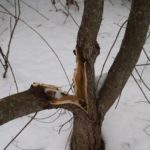 Problem: Broken branches on trees or shrubs.
Problem: Broken branches on trees or shrubs.
Cause: Weight from snow and ice, either from the elements or from snow shoveling or plowing.
Remedy: Prune any broken branches below the break. This clean cut will encourage the fastest healing of the bark and the best chance for preventing disease and insect damage. Some branches may break and peel the bark or inner tissues of another main branch or the trunk. Response should be determined by the level of severity:
- For severe cases, the plant may need to be removed and replaced; consult with an arborist.
- For moderate cases, the broken branch and the adjoining branch should both be removed.
- For mild cases, the cut should be made as clean as possible and the open wound may be left to heal. The plant may be able to close this wound successfully or it may result in disease or decay.
According to Dr. Alex Shigo, a leader in the tree care industry, wound dressings are not recommended for these injuries. They may enhance the appearance of the wound in the short term, but tend to cause more damage in the long term when compared to the control in his studies. (Shigo 1986)
Prevention: 1) Select trees with healthy looking branch connections to the main trunk. 2) Select trees with a single leader (main trunk). 3) Proper pruning while plants are young can reduce stress at the branch collar (thickened tissue at branch attachment). 4) Avoid loading plants with excess snow during plowing and shoveling. 5) Where feasible, knock heavy loads of snow off shrubs or small trees. 6) For large species, such as pines, where branch shedding is common, plant far away from homes, cars, and other structures to reduce the risk of property damage.
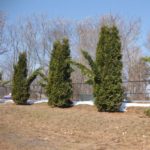 Problem: Splayed open branches on trees or shrubs. Bark and inner tissues are not damaged, but severely bent.
Problem: Splayed open branches on trees or shrubs. Bark and inner tissues are not damaged, but severely bent.
Cause: Weight from snow and ice, either from the elements or from snow shoveling or plowing.
Remedy: For splayed open branches on trees and shrubs, some will bounce back on their own after the weight of the snow or ice has diminished. Japanese Hollies (Ilex crenata) are common shrubs that respond this way. Other plants, such as Arborvitae (Thuja sp.) may need some assistance by being tied back together. The preferred material should have some give to it. Plant tie tape is commonly available at garden centers or old bed sheets cut into strips work well too. Avoid using wire or thin string that may cut into the bark. If the tying material cannot be removed after one year, the material used should be inspected and retied annually to avoid girdling the plant. Corrective pruning may be done to trees and shrubs to create more compact branching structure.
Prevention: 1) Select trees with a single leader. 2) Prune young trees and shrubs to establish a more compact branching structure. 3) Before a large storm, it may be advantageous to tie up plants like Arborvitae in preparation and remove the tie after the event.
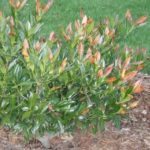 Problem: Defoliation or brown leaves of evergreens in the winter, possibly looking wilted. More often seen in broadleaf evergreens than needle evergreens.
Problem: Defoliation or brown leaves of evergreens in the winter, possibly looking wilted. More often seen in broadleaf evergreens than needle evergreens.
Cause: Excessive wind wicks moisture away from leaf surface, also known as desiccation.
Remedy: Prune damaged portions of the plant.
Prevention: 1) Select wind tolerant plants. Use plants sensitive to wind damage in protected locations, like close to a building or surrounded by other plants. 2) For established plants prone to damage, use an anti-desiccant spray to protect the foliage. Anti-desiccant is a waxy product that protects the plant from wind; follow label directions for timing and application, as it is rather specific. 3) Install wind-breaks around your property. Prevailing winter winds tend to come from the west-northwest and speeds are increased across sites with few obstacles to slow the wind down. A strategically placed cluster of trees can do wonders to slow wind on a site and often help with energy savings in a home or office.
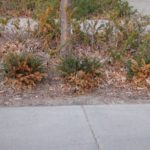 Problem: Brown leaf tips or needles, or whole sections of the plant looking brown.
Problem: Brown leaf tips or needles, or whole sections of the plant looking brown.
Cause: Salt damage from de-icing products leaching into soil or sprayed onto the plant.
Remedy: If the damage is severe (i.e. the whole plant is brown or appears dead) the plant will need to be removed and replaced. If just part of the plant looks damaged, break open the soil around the plant, without damaging the roots too much, and irrigate the plant heavily to flush salts from soil.
Prevention: 1) Select salt-tolerant plants for along walkways, driveways, and roads that receive salt as a de-icer in the winter. 2) Switch de-icing product to an alternative such as calcium magnesium acetate (CMA) or use a traction control product such as sand or kitty litter instead of a de-icer. 3) In low-traffic areas, avoid using any de-icer, which will further protect plants and turf.
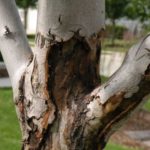 Problem: Splitting bark or discoloration on trunk of tree, typical of young trees on the sunniest side
Problem: Splitting bark or discoloration on trunk of tree, typical of young trees on the sunniest side
Cause: Sunscald Injury or Southwest Winter Injury from sun warming up cold, dormant cells on the southwest side of the tree causing the cells to become active. The cells lose some of their cold-hardiness and become damaged when the sun goes away.
Remedy: Assess the level of injury and watch the health of the tree in spring. If the tree is severely injured, it will need to be removed and a new one installed in its place. The tree may be OK and grow around the damaged cells.
Prevention: 1) Know which type of tree you’re planting and whether it has thin bark when it is young. A list of species prone to sunscald are listed from Utah State University Cooperative Extension at the website cited below. 2) Wrap the trunks of young trees with white tree wrap fabric from fall through spring. White tree wrap fabric reflects the sunlight away, keeping the trunk cooler. It can be found at most home and garden centers. Another option would be to wrap the trunk in October with solid white deer protection. This will protect from both sunscald and deer rub. In either case it is important to remove the wrap in the spring to avoid harboring moisture and pests. (Wagner 2011)
I hope this guide helps you better prepare the landscape against harsh winter conditions. If you are unsure of the cause or solution to issues you see around your property or you just don’t have the right equipment to handle the issue, the staff at GreenWeaver is happy to look at your site, any time of year. Remember: prevention of these problems is key, but if you have an established landscape, management is the next best course of action.
Works Cited:
Shigo, A.L. 1986. A new tree biology and dictionary: Facts, photos, and philosophies on trees and their problems and proper care. 11th ed. Shigo, Snohomish, W.A.
Wagner, Katie and Michael Kuhns. 2011. Sunscald Injury or Southwest Winter Injury on Deciduous Trees. Utah State University Cooperative Extension. 28 January 2015. <http://extension.usu.edu/files/ publications/factsheet/NR_FF_021pr.pdf>

